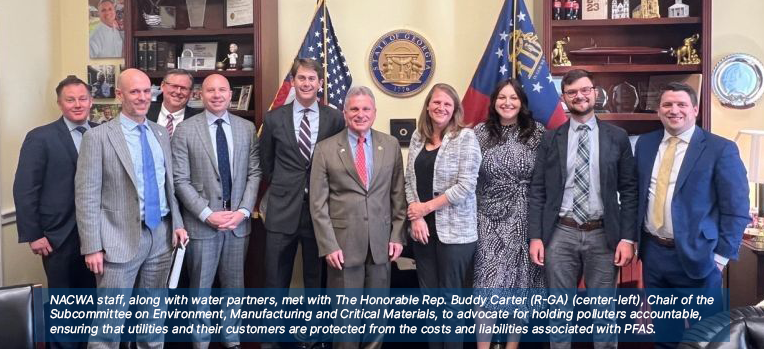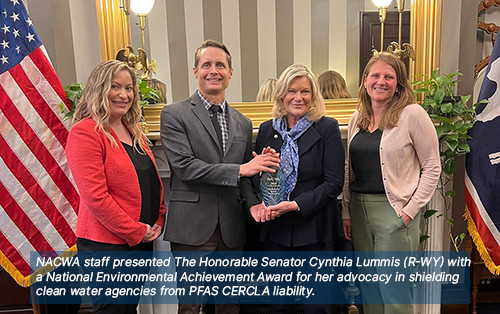The technical, operational, and financial challenges that confront clean water agencies due to PFAS are among the greatest threats the sector has seen. As federal and state regulators race to control PFAS pollution – after decades of industrial use – clean water agencies are caught in the crosshairs. Some in the environmental activist community, media and the general public are pointing to clean water agencies as polluters, trying to build the case that utilities are part of the problem, rather than part of the solution.
NACWA is working across all available advocacy avenues to refute this message and push for logical solutions. Protecting public health and the environment requires greater focus on source control, regulations that reflect risk and are rooted in sound science, ensuring burdens accrue to polluters, not the public, and ensuring that clean water agencies can continue to sustainably provide vital services in their communities.

NACWA’s advocacy on PFAS issues generally, and on protecting biosolids land application specifically, continues to highlight the collective value of NACWA’s integrated regulatory, legislative, legal, and communications advocacy expertise. Our efforts this year have included:
- Targeted advocacy and dialogue with U.S. EPA about the threat to land application and the need to proactively protect land application of biosolids.
- Participation in a three-part facilitated workshop initiated by U.S. EPA at NACWA’s urging to bring together federal and state regulators with the regulated clean water agency and solid waste communities to focus on the growing biosolids management challenges brought on by PFAS. The workshop underscored for senior EPA decision makers the impacts states and utilities will face if any of the biosolids management pathways are eliminated.
- Persistent engagement with U.S. EPA regarding the impact of the Comprehensive Environmental Response, Compensation, and Liability Act (CERCLA) on the public clean water community. This led to recognition in an Enforcement Discretion and Settlement Policy that EPA does not intend to pursue entities including publicly owned treatment works, municipal stormwater systems, and farms where biosolids are applied.
- Working with U.S. EPA in support of developing an appropriate national biosolids standard for PFAS through engagement in its Biosolids Risk Assessment process.

- Successfully urging the Agency to drop its biosolids sampling proposal as part of its unrelated Influent Study. The biosolids portion will now be appropriately postponed until the Agency’s Biosolids Risk Assessment is complete.
- Continuing to organize the Water Coalition Against PFAS, which is focused on securing an exemption for the water sector from CERCLA liability for PFAS. Bipartisan legislation protecting water systems has been introduced in the U.S House of Representatives to complement continued Senate-led negotiations.
- Engaging on several state level proposals to restrict biosolids land application that could potentially set concerning precedent.
- Releasing a report highlighting the cost impacts of PFAS to members.
- Developing numerous resources, including:
- PFAS CERCLA Primer for Clean Water Utilities
- Utility PFAS CERCLA Checklist
- Reportable Quantities Calculator for Use in Evaluating CERCLA Responsibilities
- Communications Toolkit for PFAS and Biosolids
- PFAS Considerations Document
NACWA’s work on these fronts is ongoing and we are readying additional resources in anticipation of key developments this fall, including the conclusion of U.S. EPA’s Biosolids Risk Assessment for PFOA and PFOS and the imminent release of human health water quality criteria for certain PFAS. We are well-poised with strong working relationships and recognized expertise among U.S. EPA and Congressional staff, to continue navigating these highly charged issues and to serve as a resource for clean water agencies nationwide.
For more information visit the PFAS Resources webpage.